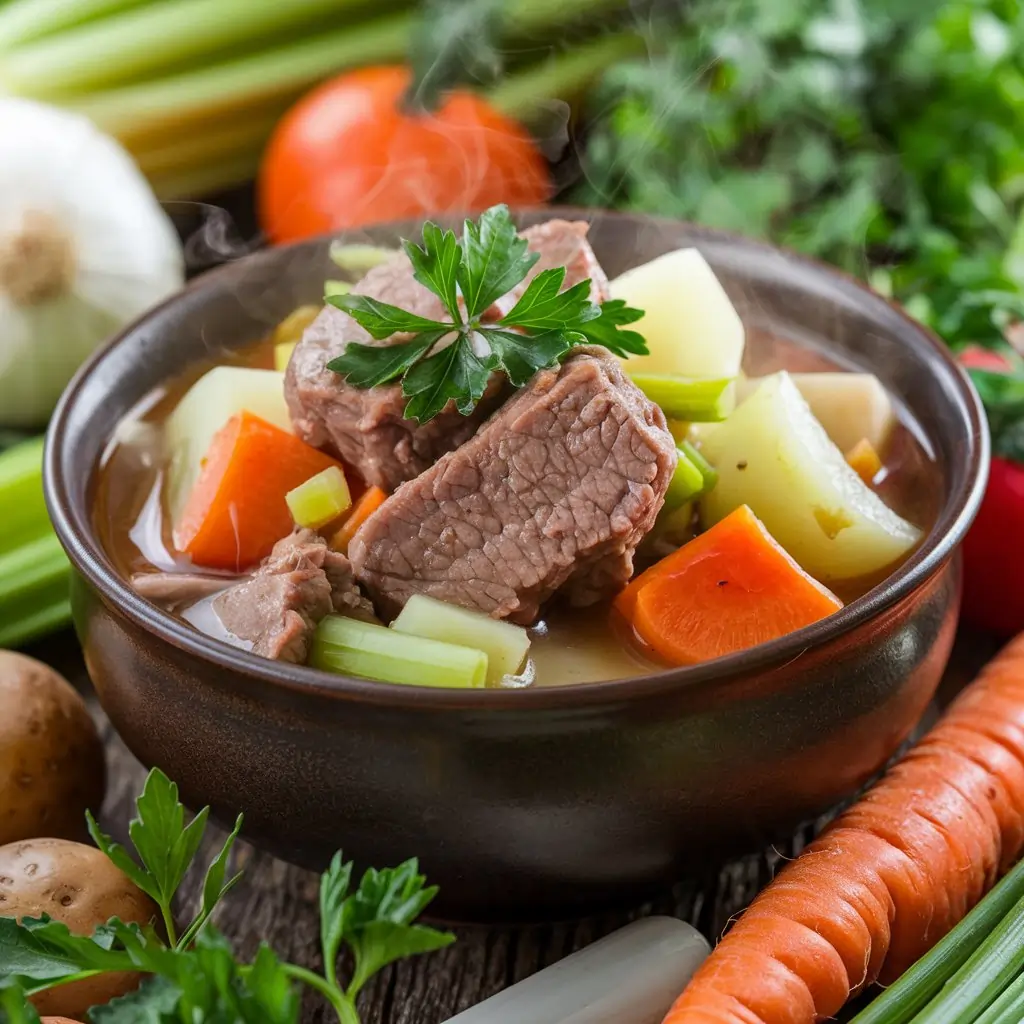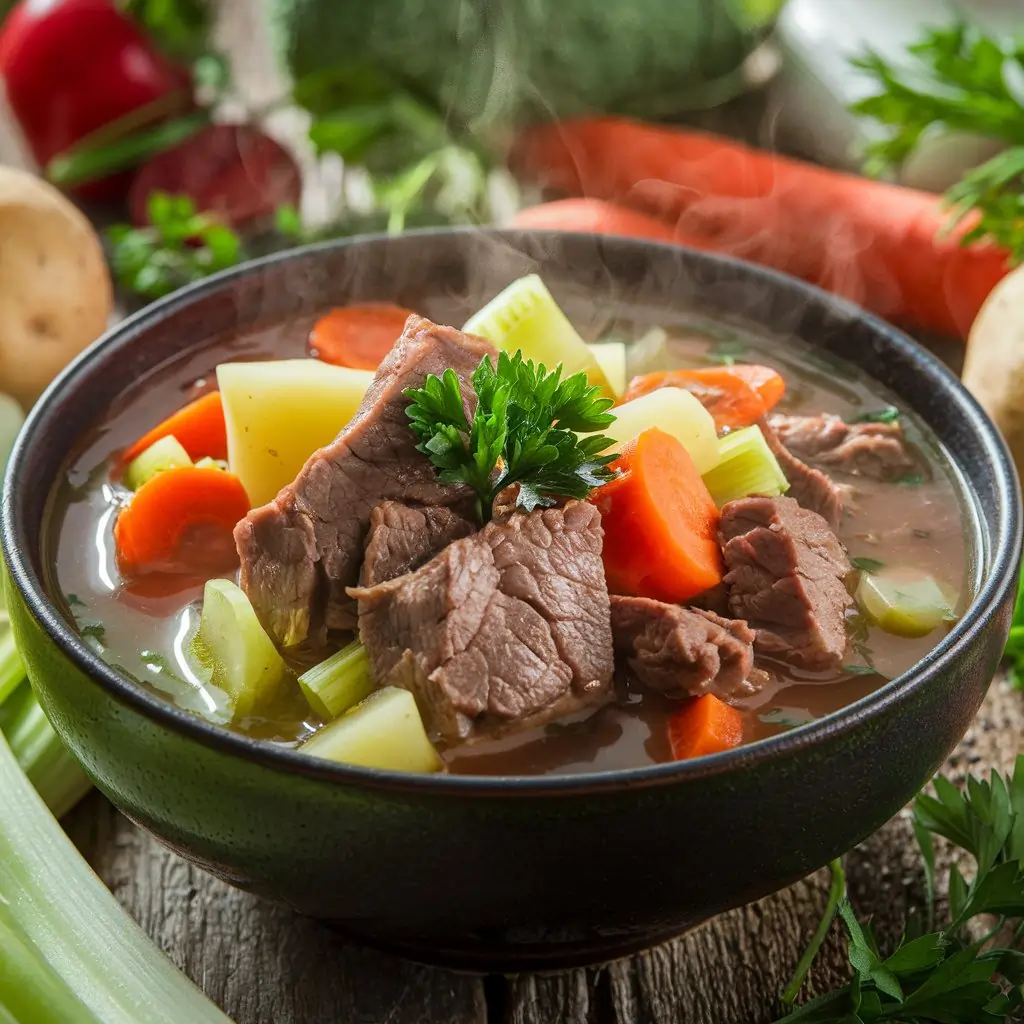There’s something magical about a warm bowl of beef and vegetable soup. It’s more than just food; it’s a hug in a bowl. Whether it’s a chilly evening or a casual family dinner, this classic dish never fails to hit the spot. But what makes it so special? Is it the hearty beef, the nutritious vegetables, or the medley of flavors that blend together in perfect harmony? Let’s dive deep into everything you need to know about beef and vegetable soup, from its origins to its many variations.
Table of Contents
Introduction
Beef and vegetable soup has stood the test of time, transcending cultures and cuisines. From rustic kitchens to gourmet restaurants, it’s a dish that appeals to everyone. Whether you’re looking to warm up during the winter or enjoy a healthy yet satisfying meal, this soup checks all the boxes. Plus, it’s incredibly versatile—no two recipes are exactly the same.
Block Quote:
“Beef and vegetable soup isn’t just a dish; it’s a journey through flavor, comfort, and tradition.”
Let’s get started on this culinary adventure!
What Makes Beef and Vegetable Soup Special?
The History and Popularity of Beef and Vegetable Soup
Did you know that beef and vegetable soup has been enjoyed for centuries? Its roots can be traced back to ancient times when people combined available ingredients into hearty stews. Over the years, this dish evolved into the beloved soup we know today, with countless regional variations. From French pot-au-feu to American beef stew, each version tells its own story.
Nutritional Benefits of Beef and Vegetable Soup
Packed with vitamins, minerals, and protein, this soup is a nutritional powerhouse. The beef provides essential nutrients like iron and zinc, while the vegetables are loaded with fiber and antioxidants. Plus, it’s a low-calorie meal that keeps you full and energized. Isn’t that the perfect combo? 🌟
Ingredients for the Perfect Beef and Vegetable Soup
When it comes to making beef and vegetable soup, using the right ingredients can make all the difference. Let’s break down what you’ll need to create a truly flavorful and satisfying dish.
Choosing the Right Cut of Beef
The star of the show is the beef, so it’s crucial to choose a cut that works well for slow cooking. Here are some popular options:
- Chuck Roast: Known for its marbling, chuck roast becomes tender and flavorful when simmered.
- Brisket: A tougher cut that melts in your mouth when cooked properly.
- Beef Shank: Perfect for soups because of its rich, gelatinous texture.
Pro Tip: Look for cuts with a little fat—they’ll add depth to your broth.
Selecting Fresh Vegetables
Vegetables bring color, texture, and nutrients to your soup. Here’s a list of must-haves:
- Carrots: Sweet and hearty, they balance the richness of the beef.
- Celery: Adds a subtle crunch and earthy flavor.
- Potatoes: Choose waxy varieties like Yukon Gold to avoid mushiness.
- Onions and Garlic: These aromatics form the foundation of your soup’s flavor profile.
Feel free to experiment with seasonal veggies like zucchini, green beans, or parsnips!
Optional Ingredients for Added Flavor
Want to take your soup to the next level? Consider adding:
- Herbs: Fresh thyme, parsley, and bay leaves infuse your soup with aromatic goodness.
- Tomato Paste: A dollop adds a rich, umami flavor.
- Beef Stock or Bone Broth: These provide a robust base that water simply can’t match.
Step-by-Step Guide to Preparing Beef and Vegetable Soup
Now that you have your ingredients, it’s time to bring everything together. Follow these steps for a soup that will impress your taste buds.
Prepping the Ingredients
- Chop Your Veggies: Cut vegetables into bite-sized pieces for even cooking.
- Season the Beef: Sprinkle salt, pepper, and a touch of paprika over the beef chunks.
- Brown the Meat: Sear the beef in a hot pot until it forms a crust. This step locks in flavor.
Tip: Don’t skip browning the beef! It adds a deep, caramelized flavor to your soup.
Cooking Techniques for the Best Flavor
- Sauté Aromatics: In the same pot, cook onions and garlic until translucent.
- Deglaze the Pot: Pour in a splash of red wine or beef broth to lift all those flavorful bits stuck to the bottom.
- Simmer Everything Together: Add beef, vegetables, and your chosen stock. Bring to a boil, then reduce the heat and simmer for 1-2 hours.
Let your kitchen fill with the mouthwatering aroma of homemade soup. 😋
Common Mistakes and How to Avoid Them
Even seasoned cooks make errors. Here are a few pitfalls to watch out for:
- Overcooking Vegetables: Add delicate veggies like zucchini in the last 20 minutes to avoid mushiness.
- Under-Seasoning: Taste your soup midway through cooking and adjust salt and spices as needed.
- Tough Beef: If your beef is chewy, it likely needs more time to simmer and tenderize.
Block Quote:
“Great soup doesn’t happen by accident—it’s a labor of love with attention to detail.”

Variations of Beef and Vegetable Soup
One of the best things about beef and vegetable soup is its versatility. You can adapt it to fit your preferences, dietary needs, or cultural influences. Let’s explore some popular variations that will spice up your soup repertoire!
Traditional Recipes from Around the World
- French Pot-au-Feu: A rustic stew featuring slow-cooked beef, root vegetables, and a hint of nutmeg.
- Italian Minestrone: Add beans, pasta, and a touch of basil for a Mediterranean twist.
- Asian-Inspired Beef Soup: Include ginger, soy sauce, and bok choy for a savory, aromatic dish.
Each variation showcases unique flavors while staying true to the comforting essence of the soup. 🌍
Low-Carb and Gluten-Free Alternatives
For those watching their carbs or avoiding gluten, try these swaps:
- Replace potatoes with cauliflower or turnips.
- Use zucchini noodles or spaghetti squash instead of pasta.
- Ensure your broth is gluten-free by checking labels or making it from scratch.
These adjustments maintain the heartiness of the soup without compromising on flavor.
Vegan and Vegetarian Adaptations
Yes, you can still enjoy a “beefy” soup without meat!
- Plant-Based Protein: Use lentils, chickpeas, or textured vegetable protein as substitutes for beef.
- Rich Broth: Simmer vegetables with miso, nutritional yeast, and smoked paprika for a savory base.
- Extra Veggies: Load up on mushrooms, eggplant, and bell peppers to mimic the texture of meat.
Tips for Storing and Reheating Beef and Vegetable Soup
Homemade soup often tastes even better the next day. But how do you store and reheat it to preserve its flavor and texture? Let’s dive in.
Proper Storage Methods
- Cool Quickly: Allow the soup to cool to room temperature before refrigerating.
- Use Airtight Containers: Store in glass or BPA-free plastic containers to keep it fresh.
- Label and Date: If freezing, note the date to ensure it’s consumed within 3 months.
Pro Tip: Divide the soup into individual portions for easier reheating.
Reheating Techniques Without Losing Flavor
- Stovetop Method: Heat the soup gently over low to medium heat, stirring occasionally.
- Microwave Option: Use a microwave-safe bowl and reheat in short intervals, stirring in between.
- Add Liquid: If the soup has thickened, stir in a bit of water or broth to restore the original consistency.
Can You Freeze Beef and Vegetable Soup?
Absolutely! Freezing is a great way to save leftovers for future meals.
- Avoid freezing soups with potatoes, as they can become grainy.
- Use freezer-safe bags and lay them flat for easy storage.
- Thaw overnight in the refrigerator before reheating for best results.
Block Quote:
“Soup is the gift that keeps on giving—perfect for meal prep and busy days!”
Common Problems and Their Solutions
Even the best cooks face challenges in the kitchen. Here’s how to tackle common issues with beef and vegetable soup.
Why Is My Soup Bland?
A bland soup can ruin the experience, but it’s easy to fix:
- Add a splash of vinegar or a squeeze of lemon to brighten the flavor.
- Sprinkle in additional salt, pepper, or herbs like thyme and oregano.
- Incorporate umami-rich ingredients like soy sauce, Worcestershire sauce, or tomato paste.
How to Fix Overcooked Vegetables
Overcooked veggies can turn your soup into a mushy mess. Here’s what to do:
- Remove the overcooked vegetables with a slotted spoon and replace them with fresh ones.
- Cook the new vegetables only until tender.
- Blend a portion of the soup for a thicker texture if removing the veggies isn’t an option.
Dealing with Tough Beef Chunks
No one wants chewy beef in their soup. To fix this:
- Simmer the soup longer—tough cuts need time to break down.
- Add a splash of acidic liquid like red wine or vinegar, which helps tenderize meat.
- Cut the beef into smaller pieces to make it easier to chew.
FAQs About Beef and Vegetable Soup
Curious about common questions surrounding beef and vegetable soup? Let’s clear up some uncertainties and provide helpful answers to make your soup experience even better.
How Long Does It Take to Make Beef and Vegetable Soup?
The cooking time depends on the cut of beef and the method you use. Generally:
- Stovetop: 1.5 to 2 hours for tender beef and fully cooked vegetables.
- Slow Cooker: 6-8 hours on low heat or 3-4 hours on high heat.
- Pressure Cooker: Just 30-40 minutes for a quick and flavorful soup.
For the best results, allow the soup to simmer slowly—good things take time!
Can I Use Leftover Beef?
Absolutely! Leftover roast or steak works wonderfully in this soup.
- Shred or chop the beef into small pieces for even distribution.
- Add the cooked beef during the last 20 minutes of cooking to avoid overcooking.
Using leftovers not only saves time but also reduces waste—a win-win! 🌟
What Are the Best Spices for This Soup?
Spices can make or break your soup. Some popular options include:
- Bay Leaves: Adds depth and subtle earthy flavor.
- Thyme and Rosemary: Enhance the savory profile of the dish.
- Paprika or Smoked Paprika: Brings a slight kick and smoky undertone.
Experiment with spice combinations to find your favorite flavor profile.
Is Beef and Vegetable Soup Healthy?
Yes, it’s a nutritious choice! It provides:
- Protein: From the beef, essential for muscle repair and energy.
- Fiber: From the vegetables, promoting healthy digestion.
- Vitamins and Minerals: Including Vitamin A (carrots), Vitamin C (celery), and iron (beef).
For an even healthier version, reduce salt and use leaner cuts of beef.
Can I Make It Ahead of Time?
Definitely! Beef and vegetable soup tastes even better the next day as the flavors meld.
- Refrigerate the soup for up to 4 days in an airtight container.
- Reheat gently to avoid overcooking the vegetables or beef.
Making it ahead is perfect for meal prep or hosting gatherings!
Conclusion: Savoring the Comfort of Beef and Vegetable Soup
Beef and vegetable soup is more than just a meal—it’s a tradition, a comfort food, and a source of nourishment. Whether you stick to the classic recipe or experiment with global variations, this dish is sure to bring warmth and satisfaction to your table.
With its rich broth, tender beef, and hearty vegetables, every spoonful is a reminder of how simple ingredients can create extraordinary flavors. So, why not grab your favorite pot and start cooking? Your perfect bowl of soup awaits!

